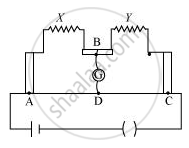Advertisements
Advertisements
Question

The figure shows experimental set up of a meter bridge. When the two unknown resistances X and Y are inserted, the null point D is obtained 40 cm from the end A. When a resistance of 10 Ω is connected in series with X, the null point shifts by 10 cm. Find the position of the null point when the 10 Ω resistance is instead connected in series with resistance ‘Y’. Determine the values of the resistances X and Y.
Solution
For a metre bridge:
`X/Y = l_1/(100 - l_1)`… (1)
Where, it is given that l1 = 40 cm
`X/Y = 40/(100 -40) = 2/3`… (2)
When 10 Ω resistance is added in series to X, null point shifts by 10 cm.
`(X+10)/Y = (40+10)/(100 - (40 +10))`
`X +10 = 50/50`
`(X+10)/Y = 1 or X+10 = Y ..... (3)`
Substituting the value of X from equation (2), we obtain
`2/3y+10 = Y`
`10 = Y -2/3 Y`
or
`Y/3 =10`
`Y =30 Omega`
Substituting the value of Y in equation (3), we obtain
X + 10 = 30
X = 20 Ω
Position of the null point when 10 Ω resistance is put in series with Y,
`20/(30+10) = l_i/(100 - l_i)`
`2000 - 20l_1 = 40l_1`
`60l_1 = 2000`
`l_1 = 2000/60`
`l_1 = 33.3 cm`
APPEARS IN
RELATED QUESTIONS
A cell balances against a length of 200 cm on a potentiometer wire, when it is shunted by a resistance of 8Ω. The balancing length reduces by 40 cm, when it is shunted by a resistance of 4 Ω . Calculate the balancing length when the cell is in open circuit. Also calculate the internal resistance of the cell.
Why are the connections between the resistors in a meter bridge made of thick copper strips?
Why is it generally preferred to obtain the balance point in the middle of the meter bridge wire?
Which material is used for the meter bridge wire and why?
When a resistance of 12 ohm is connected across a cell, its terminal potential difference is balanced by 120 cm length of potentiometer wire. When the resistance of 18 ohm is connected across the same cell, the balancing length is 150 cm. Find the balancing length when the cell is in open circuit. Also calculate the internal resistance of the cell.
Write the principle of working of a metre bridge
Two resistances are connected in the two gaps of a meter bridge. The balance points is 20 cm from the zero end. When resistance of 15 ohm is connected in series with the smaller of the two resistances, the null point shifts to 40 cm. The smaller of the two resistances has the value (in ohm) ______.
When a metal conductor connected to left gap of a meter bridge is heated, the balancing point ______.
In a sensitive meter bridge apparatus the bridge wire should possess ______.
